
Concept explainers
(a)
Interpretation:
The IUPAC name for the given compound is to be determined.
Concept introduction:
In case of molecules containing a
If the root is a chain, numbering begins from that end of the chain which encounters the
The carbon atoms having a double or triple bond between them are always assigned C1 and C2, if the root is a ring. This must be done such that the locator numbers for the substituents are minimized. The lower of the two locator numbers for the
Answer to Problem B.27P
The IUPAC name for the given compound is
Explanation of Solution
The given molecule is:
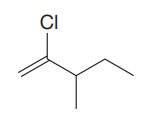
In this molecule, the longest carbon chain containing the double bond has five carbon atoms. Hence, the root is pentene. The root is numbered such that the double bonded carbon atoms get the lowest numbers. Thus, the chain should be numbered from the left-terminal carbon atom. The carbon carbon double bond is present between C1 and C2 carbon atoms, and thus, the lower locator number - 1 is added immediately before the suffix, ene. Thus, the complete root name for the molecule is:
The numbering system is shown below:
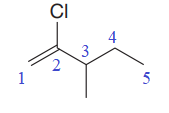
One chlorine atom and one methyl group is attached at C2 and C3 carbon atoms of the root. Out of chloro and methyl, chloro comes first alphabetically, hence it is written before the methyl.
Thus, the IUPAC name of the compound is:
The IUPAC name of the compound is written according to the rules for nomenclature.
(b)
Interpretation:
The IUPAC name for the given compound is to be determined.
Concept introduction:
In case of molecules containing a
If the root is a chain, numbering begins from that end of the chain which encounters the
The carbon atoms having a double or triple bond between them are always assigned C1 and C2, if the root is a ring. This must be done such that the locator numbers for the substituents are minimized. The lower of the two locator numbers for the
Answer to Problem B.27P
The IUPAC name for the given compound is:
Explanation of Solution
The given compound is:

In this molecule, the longest carbon chain containing the double bond has six carbon atoms. Hence, the root is hexene. The root is numbered such that the double bonded carbon atoms get the lowest numbers. Thus, the chain should be numbered from the left-terminal carbon atom. The carbon-carbon double bond is present between C1 and C2 carbon atoms, and thus, the lower locator number -1 is added immediately before the suffix, ene. Thus, the complete root name for the molecule is:
The numbering system is shown below:

One methyl group is attached at the C5 carbon atom to the root.
Thus, the IUPAC name of the compound is:
The IUPAC name of the compound is written according to the rules for nomenclature.
(c)
Interpretation:
The IUPAC name for the given compound is to be determined.
Concept introduction:
In case of molecules containing a
If the root is a chain, numbering begins from that end of the chain which encounters the
The carbon atoms having a double or triple bond between them are always assigned C1 and C2, if the root is a ring. This must be done such that the locator numbers for the substituents are minimized. The lower of the two locator numbers for the
Answer to Problem B.27P
The IUPAC name for the given compound is
Explanation of Solution
The given molecule is:

In this molecule, the largest carbon ring containing the double bond has five carbon atoms. Hence, the root is cyclopentene. For a ring, the carbon atoms of the double bond are always assigned as C1 and C2. The ring is then numbered clockwise so as to give the remaining substituents the next lowest possible locator numbers. The numbering system is shown below:
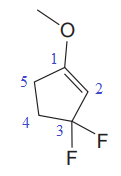
At C1, C3 and C3 carbon atoms of the ring, one methoxy group and two fluorine atoms are attached. The substituents will be named according to the alphabetical order.
Thus, the IUPAC name of the compound is:
The IUPAC name of the compound is written according to the rules for nomenclature.
(d)
Interpretation:
The IUPAC name for the given compound is to be determined.
Concept introduction:
In case of molecules containing a
If the root is a chain, numbering begins from that end of the chain which encounters the
The carbon atoms having a double or triple bond between them are always assigned C1 and C2, if the root is a ring. This must be done such that the locator numbers for the substituents are minimized. The lower of the two locator numbers for the
Answer to Problem B.27P
The IUPAC name for the given compound is
Explanation of Solution
The given compound is:
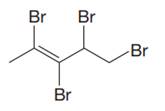
In this molecule, the longest carbon chain containing the double bond has five carbon atoms. Hence, the root is pentene. The root is numbered such that the double bonded carbon atoms get the lowest numbers. Thus, the chain should be numbered from the left-terminal carbon atom. The carbon-carbon double bond is present between C2 and C3 carbon atoms, and thus, the lower locator number - 2 is added immediately before the suffix, ene. Thus, the complete root name for the molecule is:
The numbering system is shown below:
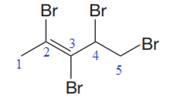
Four bromine atoms are attached at C2, C3, C4, and C5 carbon atoms to the root. Thus, prefix ‘tetra’ is used immediately before the name of the substituent.
Thus, the IUPAC name of the compound is:
The IUPAC name of the compound is written according to the rules for nomenclature.
(e)
Interpretation:
The IUPAC name for the given compound is to be determined.
Concept introduction:
In case of molecules containing a
If the root is a chain, numbering begins from that end of the chain which encounters the
The carbon atoms having a double or triple bond between them are always assigned C1 and C2, if the root is a ring. This must be done such that the locator numbers for the substituents are minimized. The lower of the two locator numbers for the
Answer to Problem B.27P
The IUPAC name for the given compound is
Explanation of Solution
The given compound is:

In this molecule, the longest carbon chain containing the double bond has six carbon atoms. Hence, the root is hexene. The root is numbered such that the double bonded carbon atoms get the lowest numbers. If there is a tie, the chain is numbered such that the substituents get the lowest locator numbers. Thus, the chain should be numbered from the left-terminal carbon atom. The carbon-carbon double bond is present between C3 and C4 carbon atoms, and thus, the lower locator number - 3 is added immediately before the suffix, ene. Thus, the complete root name for the molecule is:
The numbering system is shown below:
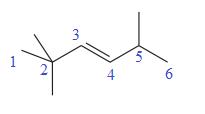
Three methyl groups are attached at C2, C2, and C5 carbon atoms to the root. Thus, prefix ‘tri’ is used immediately before the name of the substituent.
Thus, the IUPAC name of the compound is
The IUPAC name of the compound is written according to the rules for nomenclature.
(f)
Interpretation:
The IUPAC name for the given compound is to be determined.
Concept introduction:
In case of molecules containing a
If the root is a chain, numbering begins from that end of the chain which encounters the
The carbon atoms having a double or triple bond between them are always assigned C1 and C2, if the root is a ring. This must be done such that the locator numbers for the substituents are minimized. The lower of the two locator numbers for the
Answer to Problem B.27P
The IUPAC name for the given compound is:
Explanation of Solution
The given molecule is:

In this molecule, the largest carbon ring containing the double bond has four carbon atoms. Hence, the root is cyclobutene. For a ring, the carbon atoms of the double bond are always assigned as C1 and C2. The ring is then numbered clockwise so as to give the remaining substituents the next lowest possible locator numbers. The numbering system is shown below:
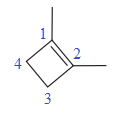
At C1 and C2 carbon atoms of the ring, two methyl groups are attached respectively. Thus, prefix ‘di’ should be added immediately before the name of the substituent.
Thus, the IUPAC name of the compound is:
The IUPAC name of the compound is written according to the rules for nomenclature.
(g)
Interpretation:
The IUPAC name for the given compound is to be determined.
Concept introduction:
In case of molecules containing a
If the root is a chain, numbering begins from that end of the chain which encounters the
The carbon atoms having a double or triple bond between them are always assigned C1 and C2, if the root is a ring. This must be done such that the locator numbers for the substituents are minimized. The lower of the two locator numbers for the
Answer to Problem B.27P
The IUPAC name for the given compound is:
Explanation of Solution
The given molecule is:

In this molecule, the double bond cannot be a part of the longest carbon chain or the largest carbon ring. Thus, in this case, the double bond will be a substituent to the parent ring, cyclopentane. The numbering system is shown below:
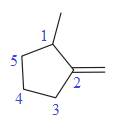
At C1 carbon atom, there is one methyl group attached to the root. At C2 carbon atom, the double bond is attached which is named as methylene.
Thus, the IUPAC name of the compound is:
The IUPAC name of the compound is written according to the rules for nomenclature.
(h)
Interpretation:
The IUPAC name for the given compound is to be determined.
Concept introduction:
In case of molecules containing a
If the root is a chain, numbering begins from that end of the chain which encounters the
The carbon atoms having a double or triple bond between them are always assigned C1 and C2, if the root is a ring. This must be done such that the locator numbers for the substituents are minimized. The lower of the two locator numbers for the
Answer to Problem B.27P
The IUPAC name for the given compound is:
Explanation of Solution
The given compound is:
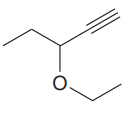
In this molecule, the longest carbon chain containing the triple bond has five carbon atoms. Hence, the root is pentyne. The root is numbered such that the triple-bonded carbon atoms get the lowest numbers. Thus, the chain should be numbered from the top right carbon atom. The carbon-carbon triple bond is present between C1 and C2 carbon atoms, and thus, the lower locator number - 1 is added immediately before the suffix, yne. Thus, the complete root name for the molecule is
The numbering system is shown below:
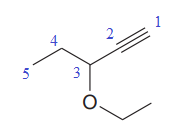
One methoxy group is attached at the C3 carbon atom to the root.
Thus, the IUPAC name of the compound is:
The IUPAC name of the compound is written according to the rules for nomenclature.
Want to see more full solutions like this?
Chapter B Solutions
EBK ORGANIC CHEMISTRY: PRINCIPLES AND M
- The following reaction is run in which the initial conditions include only methane (CH4) at a concentration of0.115 M. Once equilibrium was established, the concentration of acetylene (C2H2) was measured to be 0.035M. What is the value of the equilibrium constant, K?2 CH4 (g) ⇋ C2H2 (g) + 3 H2 (g)arrow_forwardCalculate the equilibrium concentration of carbon dioxide for the following reaction:2 COF2 (g) ⇋ CF4 (g) + CO2 (g) Kc = 2.00 at 10.00 °C. at equilibrium [COF2] = 0.255M; [CF4] = 0.118Marrow_forwardIn a benzene derivative that has -CH2CH3, indicate how it can be substituted by -COOH.arrow_forward
- In a sulfonated derivative of benzene, indicate how -SO3H can be eliminated.arrow_forwardWhat is the equilibrium expression (law of mass action) for the following reaction:CO2 (g) + H2O (l) ⇋ H+ (aq) + HCO3- (aq)arrow_forwardIndicate the compound resulting from adding NaOH cyclopentane-CH2-CHO.arrow_forward
- Use the provided information to calculate Kc for the following reaction at 550 °C: H2(g) + CO2(g) ⇌ CO(g) + H2O(g) Kc = ?CoO(s) + CO(g) ⇌ Co(s) + CO2(g) Kc1 = 490CoO(s) + H2(g) ⇌ Co(s) + H2O(g) Kc2 = 67arrow_forwardCalculate Kc for the reaction: I2 (g) ⇋ 2 I (g) Kp = 6.26 x 10-22 at 298Karrow_forwardFor each scenario below, select the color of the solution using the indicator thymol blue during the titration. When you first add indicator to your Na2CO3solution, the solution is basic (pH ~10), and the color is ["", "", "", "", ""] . At the equivalence point for the titration, the moles of added HCl are equal to the moles of Na2CO3. One drop (or less!) past this is called the endpoint. The added HCl begins to titrate the thymol blue indicator itself. At the endpoint, the indicator color is ["", "", "", "", ""] . When you weren't paying attention and added too much HCl (~12 mL extra), the color is ["", "", "", "", ""] . When you really weren't paying attention and reached the second equivalence point of Na2CO3, the color isarrow_forward
- To convert cyclopentane-CH2-CHO to cyclopentane-CH2-CH3, compound A is added, followed by (CH3)3CO-K+, DMS at 100oC. Indicate which compound A is.arrow_forwardIndicate how to obtain the compound 2-Hydroxy-2-phenylacetonitrile from phenylmethanol.arrow_forwardIndicate the reagent needed to go from cyclopentane-CH2-CHO to cyclopentane-CH2-CH=CH-C6H5.arrow_forward
 ChemistryChemistryISBN:9781305957404Author:Steven S. Zumdahl, Susan A. Zumdahl, Donald J. DeCostePublisher:Cengage Learning
ChemistryChemistryISBN:9781305957404Author:Steven S. Zumdahl, Susan A. Zumdahl, Donald J. DeCostePublisher:Cengage Learning ChemistryChemistryISBN:9781259911156Author:Raymond Chang Dr., Jason Overby ProfessorPublisher:McGraw-Hill Education
ChemistryChemistryISBN:9781259911156Author:Raymond Chang Dr., Jason Overby ProfessorPublisher:McGraw-Hill Education Principles of Instrumental AnalysisChemistryISBN:9781305577213Author:Douglas A. Skoog, F. James Holler, Stanley R. CrouchPublisher:Cengage Learning
Principles of Instrumental AnalysisChemistryISBN:9781305577213Author:Douglas A. Skoog, F. James Holler, Stanley R. CrouchPublisher:Cengage Learning Organic ChemistryChemistryISBN:9780078021558Author:Janice Gorzynski Smith Dr.Publisher:McGraw-Hill Education
Organic ChemistryChemistryISBN:9780078021558Author:Janice Gorzynski Smith Dr.Publisher:McGraw-Hill Education Chemistry: Principles and ReactionsChemistryISBN:9781305079373Author:William L. Masterton, Cecile N. HurleyPublisher:Cengage Learning
Chemistry: Principles and ReactionsChemistryISBN:9781305079373Author:William L. Masterton, Cecile N. HurleyPublisher:Cengage Learning Elementary Principles of Chemical Processes, Bind...ChemistryISBN:9781118431221Author:Richard M. Felder, Ronald W. Rousseau, Lisa G. BullardPublisher:WILEY
Elementary Principles of Chemical Processes, Bind...ChemistryISBN:9781118431221Author:Richard M. Felder, Ronald W. Rousseau, Lisa G. BullardPublisher:WILEY





